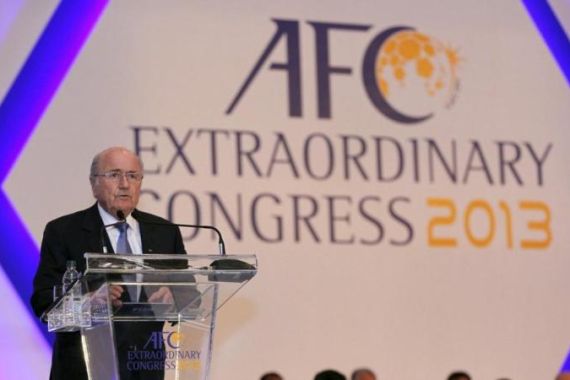Asian football and the World Cup question
With the east boosting football’s economy, isn’t it time for continent to get better representation on the world stage?

Over the next week or two, Asian football will be focused on the second round of the 2013 Asian Champions League.
The sixteen teams standing are still divided into the western and eastern zones. In the west, there are three Saudi Arabian-Qatari clashes. Over in the east, it is more mixed with, for the first time, six nations represented.
Keep reading
list of 4 itemsHolders Man City go out of Champions League on penalties to Real Madrid
Barca crash out as Mbappe brace leads PSG to Champions League last four
Saudi reviews football fan rules after whip attack
South Korea and China have two each while Australia, Japan, Uzbekistan and Thailand also have a horse left in the race.
In the medium term however, the powers-that-be on the continent are ready to talk about an even bigger prize – increasing the 4.5 World Cup spots allocated to the AFC and its 46 full members.
|
“It’s important we don’t ask for it just for the sake of asking for it. It must be a target to develop Asian football and raise the standards of the game around the continent” Qatar 2022 General Secretary, Hassan Al-Thawadi |
The clarion call was sounded by FIFA president Sepp Blatter on May 2. The Swiss supremo has a reputation for telling audiences what they want to hear and as he was talking to all 46 full members of the AFC Congress in Kuala Lumpur, his words should be taken with the usual amount of salt.
“We have to have a better balance. You are a powerhouse, you must be aware of your powerhouse.”
It may have been more blather from Blatter but he had a point. Over four billion people call Asia home but in terms of the World Cup, 60% of all humanity gets about 16% of the representation.
And as the FIFA boss pointed out, roughly half of the regular $1 billion income received by the world governing body rolls into Switzerland from the east. At the most basic level, it’s just not fair.
The man behind Qatar’s successful 2022 World Cup bid Hassan Al-Thawadi recently saw his attempt to win election to FIFA’s powerful Executive Committee defeated by Sheikh Salman, who also won the AFC presidency. The charismatic Al Thawadi, also the General Secretary of the 2022 Supreme Organising committee, believes it is an issue worth discussing.
“It is something we need to look at,” he told Al Jazeera.
“That goes hand-in-hand with the development of the AFC. It is always a difficult issue as every continent wants more spots. It’s important we don’t ask for it just for the sake of asking for it. It must be a target to develop Asian football and raise the standards of the game around the continent and more World Cup spots could make a big difference.”
Bigger role
New AFC chief Salman agrees that it is time for more and he will get the chance to make his case when FIFA meets in Mauritius at the end of May. The problem is, of course, that if Asia gains a spot then someone, somewhere else has to lose one.
Football politics can seem remote to fans but when it comes to the World Cup, deals done have a very visible and emotive effect. Already Michel Platini, UEFA President, has said that he sees no reason to increase Asia’s allocation which basically means he sees no reason to decrease that of his own confederation.
But as Blatter pointed out, Europe and South America have 19 of the 32 spots in 2014. These two traditional powerhouses have shared the World Cup trophy since its inception and it will be a surprise if that is not continued in Brazil next year.
The viewpoint that South America’s five spots for its ten members is unfair is not an exclusively Asian one but when all five made the second round in South Africa and four made the last eight, it will take a good argument to deprive CONMEBOL. And then there is UEFA and its 13 spots but once again, Europe did provide all four semi-finalists.
Yet, be made the argument must. For the World Cup to be truly global, Asia deserves a bigger role. At the very least, its 4.5 spots must be upgraded to five.
There is no denying that the continent does not have a record to rank alongside the traditional powerhouses. But then there is no denying that it is relatively difficult to do so when, proportionally, South American teams have around five times more access than those from the east.
The more teams play at the World Cup, the better they perform. Japan and South Korea have shown what regular experience can do and after uncertain early appearances are now familiar faces in the knockout stage. Australia were narrowly beaten by eventual champions Italy in the second round in 2006 and were unlucky not to progress from a tough group four years later.
Asia’s best no longer are satisfied with simply making up the numbers and these days aim for the latter stages, the others just need a little more experience. When Europe and South America 60% of the places every time, it is hardly surprising that their battle-hardened teams are the ones left standing. The odds are stacked in their favour.
It’s time for a little redistribution. It is not a question of if but when.